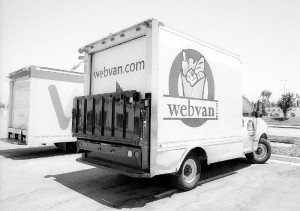When it came time for Jeff Bezos to install a team to lead Amazon’s new subsidiary, the grocery delivery service AmazonFresh, he made a startling move. Instead of selecting experts from the supermarket or delivery industries or snapping up executives from his competitors, he chose people who had failed exactly where he wanted to succeed.
This maneuver would have never happened in the early days of Amazon. In the first few years of the company, Bezos was incredibly demanding about who he would hire. He only wanted the best — which were people who had “been successful in everything they had done.”
Bezos’s thinking on hiring did an about-face as he continued to build Amazon. To hire innovators, you must move beyond conventional ideas of success, and that’s why Bezos ultimately hired failures to run AmazonFresh.
How to Rebound from Failure
Webvan was an online grocery delivery service created during the first dot-com era that had raised $375 million in funding, announced a plan to expand to 26 cities, and signed a $1 billion contract to build high-tech warehouses, all before figuring out a tenable business model.
Two years after they went public, they went bankrupt.
These days, companies like FreshDirect, Uber and Postmates have found incredible success by doing the complete opposite. They get profitable in a single city and then they scale from there. This is what made Bezos’s hire even more surprising.
He hired former Webvan executives to run AmazonFresh, the very people who had spent years running the company into the ground. They hadn’t just failed but failed big. But it was because they’d been so mistaken in their approach that they could also rebound in a big way.
After running the business process team at Webvan, former executive Mick Mountz “concluded that the company’s downfall was due to the inflexibility of existing material handling systems and the high cost of order fulfillment.” That inspired Mountz “to create a better way to pick, pack, and ship orders.” He took his learnings and founded Kiva Systems in 2003. Amazon’s warehouse technology today is powered by Kiva, which Amazon acquired in 2012 for $775 million.
When it comes to strategy today, the former Webvan execs running AmazonFresh, including Mountz, decided to roll out AmazonFresh slowly in Seattle before expanding. They’re making use of Amazon’s warehouses rather than building their own. They bounced back up from the Webvan failure with more lessons, experience, knowledge, and will — and they’re putting it all to good use.
Why Failure Goes Hand in Hand with Innovation
What Bezos had to learn at Amazon is that “failure comes part and parcel with invention.” Failure is an integral part of the process of innovating and attempting what nobody else has ever done before. If people haven’t failed before, it means they’ve been playing it safe.
This flips the concept of success on its head, meaning you might not want to recruit people with easy win after win on their resumé.
For example, Google has changed how it has hired to move away from the trappings of university prestige and test scores. The company had previously been known to be somewhere almost impossible to get a job without a Stanford or MIT degree and an exemplary college GPA. They even asked about your SAT score.
But when they analyzed their data on what makes employees successful, in true Google fashion, they found it had nothing to do with scores or names. “Numbers and grades alone did not prove to spell success at Google and are no longer used as important hiring criteria,” explains Prasad Setty, vice president for its people analytics team.
That gets at why former Yale professor William Deresiewicz calls elite college students “excellent sheep.” They’re “anxious, timid, and lost, with little intellectual curiosity and a stunted sense of purpose: trapped in a bubble of privilege, heading meekly in the same direction, great at what they’re doing but with no idea why they’re doing it.” They’re violently averse to risk as a product of being shackled by their academic success.
What Google has instead found out, based on extensive surveys of its work force and performance data, is that its most innovative workers “are those who have a strong sense of mission about their work and who also feel that they have much personal autonomy.” They’re guided by their own curiosity and sense of purpose, and as a result, they do their best work.
* * * * *
We want the best and brightest to work with us, but the way to hire innovators means looking past the traditional trappings of success and looking at the boldness of someone’s trajectory.
Forget about pedigree and a C.V. glowing with only success. Achievement isn’t about always being right or following the path simply because others have trodden it before you.
Instead, hire people who’ve failed at doing something daring, because they’re the only ones who’ll succeed at something bold.
Photo: Kay Kim
P.S. If you liked this article, you should subscribe to our newsletter. We’ll email you a daily blog post with actionable and unconventional advice on how to work better.



